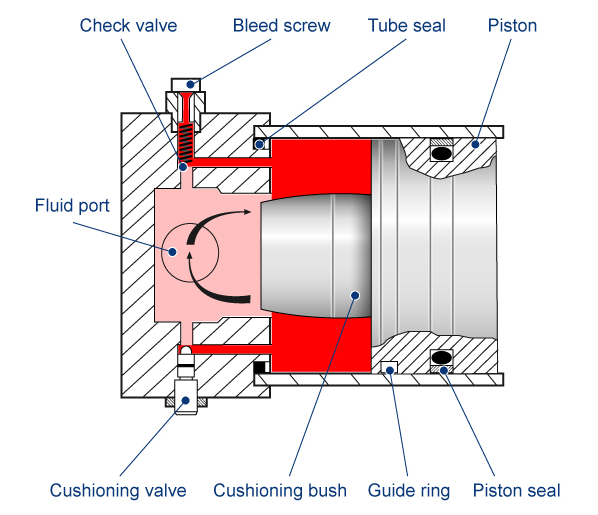HYDRAULIC CYLINDER CUSHIONING
Introduction to Hydraulic Cylinder Cushioning
For every hydraulic application, the most common component will be a hydraulic cylinder that extends and retracts with the effect of pressurized fluids. With a hydraulic cylinder, it is possible for lifting, pulling, and pushing heavy loads safely and effectively. The hydraulic cylinder using the flow of pressurized fluid will create a mechanical force in a linear motion.
Barrel, piston, and piston rod are the main components of any hydraulic cylinder. The piston attached to the piston rod will move back and forth through the barrel with the action of fluid intake and removal. During fluid intake, the piston rod extends and when the fluid flows out, the piston rod retracts. Each operation means that there will be a movement of piston rod through the barrel whenever the hydraulic system is operated. This continuous operation under high pressure can affect the lifespan of the cylinder because of vibration/shock generated due to this action. How to solve this mentioned issue?
The vibration/shock generated will be high if the piston rod hits the cylinder barrel at a greater speed. By controlling the fluid pressure we can reduce the damage to a greater extent. But, one of the major advantages of hydraulics is speed and if the fluid pressure is reduced in order to control the speed of the piston rod, then the entire system will move towards failure, or the required performance will not be obtained. Hydraulic cylinder cushioning is a method that is mentioned in this article to eliminate hydraulic cylinder damage.
WHAT IS HYDRAULIC CYLINDER CUSHIONING?
Hydraulic cylinder cushioning is a technology that slows down the piston when it reaches the end of their stroke. This is a comparatively inexpensive method used with both pneumatic and hydraulic cylinders to reduce damages caused as a result of shock waves resulting from pressure spikes. A simple cushioning plunger is attached with the piston rod and it will act as a metering device that decelerates the cylinder when it reaches a few inches before it strikes end cap. This deceleration occurs because of the fluid flow restriction generated by the plunger. The major advantages of hydraulic cylinder cushioning are:
⦁ Extends the cylinder life by reducing the impact of vibration
⦁ Reduces undesirable noise
⦁ Mostly deceleration process is automatic, adjustable, and requires less maintenance
⦁ Commonly used for moving heavy loads or travel at high speeds
The parameter that determines whether hydraulic cushioning is required or not is the kinetic energy. This kinetic energy depends on two parameters: that are moving mass and speed. To calculate the kinetic energy, use:
E=½*m*v2
When cylinder piston rod approaches the end of the stroke, with cushioning the kinetic energy will be converted into:
E=Fa*ΔL
Here, Fa is the cushioning force that is generated with damping travel of ΔL.
How do hydraulic cylinder cushioning decelerate cylinder? As mentioned, the cylinder retracts when the fluid flows outwards and when the piston rod approaches the end cap. In a cushioned hydraulic cylinder, the cushion plunger will enter into the cushion cavity when it approaches the end cap. The fluid flow will be restricted due to this action and back pressure will generate that decelerate the cylinder speed. A small adjustable opening is located on the end cap through which this fluid can flow outwards and this determines the degree of cushioning by adjusting the screw on the end cap. Generally, cylinder cushioning is used by double-acting cylinders that are used in heavy applications like cargo handling cranes or harbor mobile cranes, Heavy Honing Machines, Vertically Forced Hydraulic Press (In forging, Stamping etc.) and this can be integrated on one or both sides of the cylinder depending on the application.



